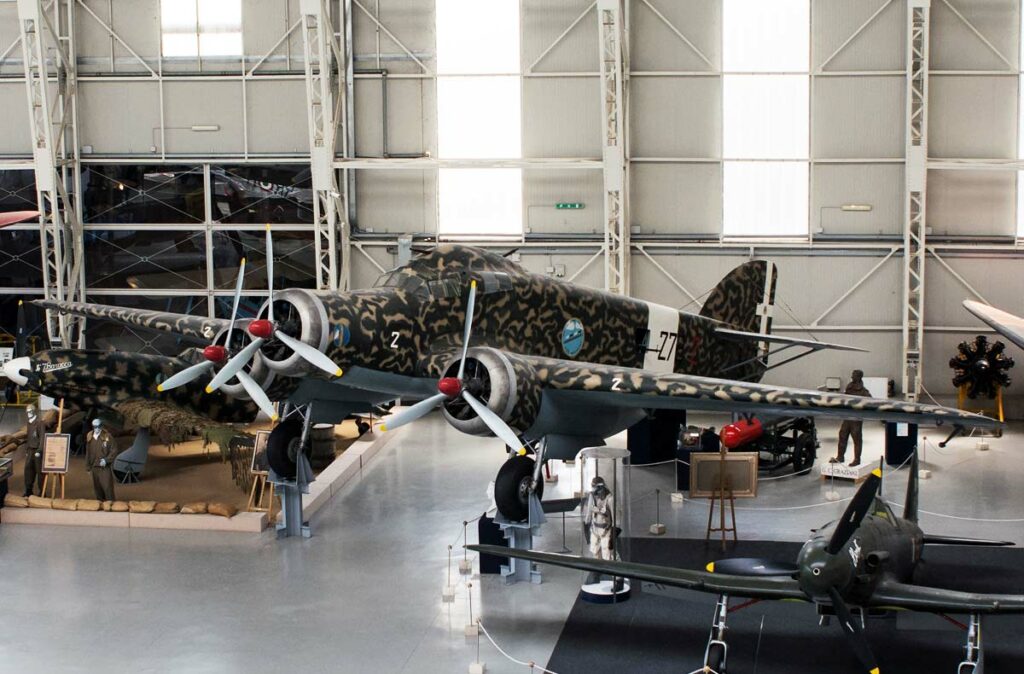The Savoia-Marchetti SM.79 Sparviero, a three-engined Italian medium bomber, was renowned for its speed, robustness, and versatility in WWII.
This article delves into the Savoia-Marchetti SM.79 Sparviero, a significant Italian medium bomber of WWII. We examine its development history, design characteristics, performance, and military use. The SM.79’s evolution is placed within the historical context of the 1930s, highlighting its initial objectives and subsequent wartime adaptations. The design analysis covers its unique three-engine configuration and structural features, while performance assessment includes comparisons with contemporaries. The aircraft’s combat roles, operational effectiveness, and legacy are thoroughly discussed, providing a comprehensive overview of its significance in aviation history.
The Savoia-Marchetti SM.79 Sparviero (Sparrowhawk) was a prominent medium bomber of the Italian Royal Air Force (Regia Aeronautica) during World War II. Its distinctive design and operational versatility made it one of the most recognizable and effective Italian bombers of the era.
History of the Development of the Savoia-Marchetti SM.79 Sparviero:
In the early 1930s, Italy, under the fascist regime of Benito Mussolini, was keen to modernize its military, particularly the Regia Aeronautica. The Savoia-Marchetti SM.79 was developed in this context, initially envisioned as a fast civilian transport aircraft.
Savoia-Marchetti, an established Italian aircraft manufacturer, began the development of the SM.79 in 1934, with chief designer Alessandro Marchetti. The prototype first flew on September 28, 1934. While it did not have a NATO nickname due to its pre-NATO era development, it quickly became known as the “Sparviero.”
The SM.79 was designed during a period of significant advancements in aviation technology, with countries racing to develop faster and more capable aircraft. Italy, aiming to project power and enhance its strategic capabilities, saw the need for a versatile, fast, and reliable bomber aircraft. The SM.79 was a response to this need, initially designed for civilian use but easily adaptable for military purposes.
Design of the Savoia-Marchetti SM.79 Sparviero:
The SM.79’s design was notable for its distinctive three-engine configuration. It measured 16.2 meters (53 feet) in length, with a wingspan of 21.2 meters (69 feet 7 inches), and a height of 4.1 meters (13 feet 5 inches). The aircraft’s structure was primarily made of wood and metal, with a fabric-covered fuselage and wings.
The three-engine design, using Alfa Romeo 126 RC.34 radial engines (or similar models in various variants), was unusual but offered several advantages. It provided redundancy, increasing survivability in case of engine failure, and allowed for a higher top speed and payload capacity compared to twin-engine designs.
The bomber could carry a maximum bomb load of up to 1,250 kilograms (2,756 pounds). It also featured defensive armaments, including machine guns in dorsal, ventral, and lateral positions. However, the design had its drawbacks, including a relatively cramped crew compartment and limited defensive firepower, making it vulnerable to enemy fighters.

Performance of the Savoia-Marchetti SM.79 Sparviero:
The SM.79 was powered by three radial engines, each producing around 780 horsepower. This setup enabled a maximum speed of approximately 430 kilometers per hour (267 mph), a service ceiling of 7,000 meters (23,000 feet), and a range of about 2,000 kilometers (1,243 miles).
When compared with contemporary medium bombers like the German Heinkel He 111 or the British Vickers Wellington, the SM.79 was generally faster and had a comparable bomb load, but it lagged in defensive armament and range.
Military Use and Combat of the Savoia-Marchetti SM.79 Sparviero:
The SM.79 saw extensive service during WWII, primarily with the Regia Aeronautica. It was deployed in various theaters, including the Mediterranean, North Africa, and the Eastern Front. Its roles included conventional bombing, torpedo bombing, and maritime reconnaissance.
The aircraft’s armament, while limited in comparison to larger bombers, was effective in the roles it undertook. The SM.79 gained a reputation as a formidable torpedo bomber, particularly in the Mediterranean, where it posed a significant threat to Allied naval vessels.
Competing with aircraft like the British Bristol Blenheim, the SM.79 often excelled due to its speed and robustness. However, as the war progressed, its vulnerabilities, particularly in defensive armament, became more pronounced.
The SM.79 was exported to countries like Romania, but its primary operator remained Italy. Post-WWII, the SM.79 continued to see limited use, but it was gradually phased out and replaced by more modern designs.
The Savoia-Marchetti SM.79 Sparviero remains a notable example of Italian aviation ingenuity during WWII. Its unique design, impressive speed, and operational flexibility made it a key asset for the Regia Aeronautica. Despite its limitations, the SM.79’s legacy endures, highlighting the diverse and innovative approaches to aircraft design and combat roles during this pivotal era in military aviation history.
Back to the Bombers section.